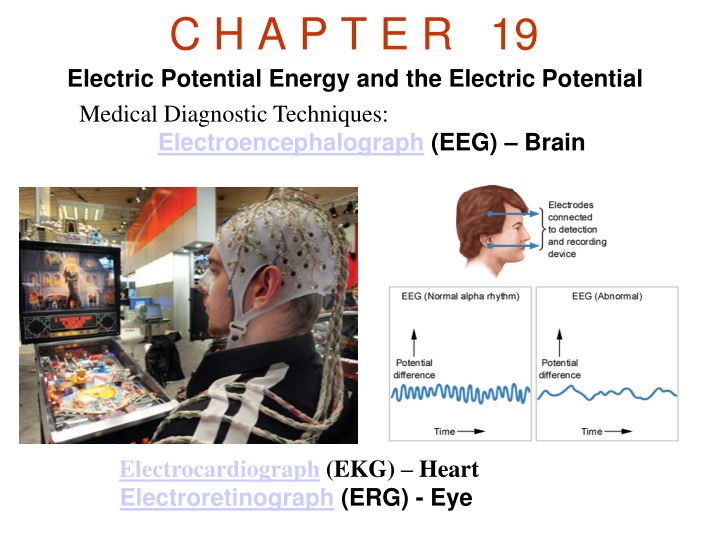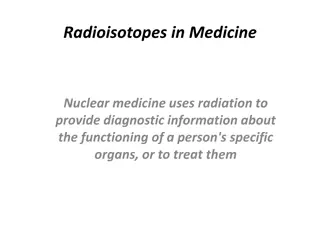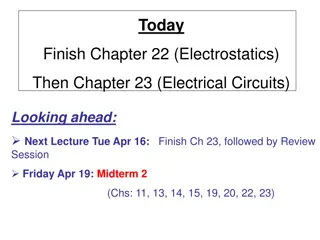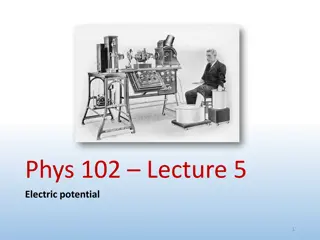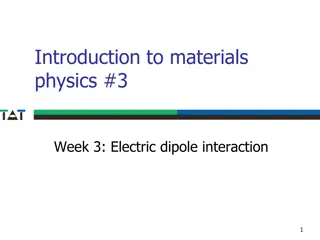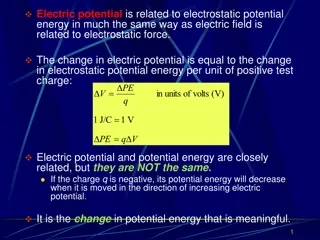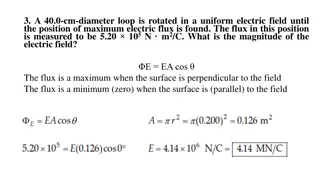Electric Potential Energy and Medical Diagnostic Techniques
This chapter covers electric potential energy, electric potential, and various medical diagnostic techniques involving electric signals such as EEG, EKG, and ERG. It discusses concepts like work done, electron volt, and equipotential surfaces, along with definitions and examples. The content delves into the significance of electric potential in understanding energy interactions and its applications in different fields. Capacitance of capacitors and their role in storing electrical charge are also explored.
Download Presentation

Please find below an Image/Link to download the presentation.
The content on the website is provided AS IS for your information and personal use only. It may not be sold, licensed, or shared on other websites without obtaining consent from the author.If you encounter any issues during the download, it is possible that the publisher has removed the file from their server.
You are allowed to download the files provided on this website for personal or commercial use, subject to the condition that they are used lawfully. All files are the property of their respective owners.
The content on the website is provided AS IS for your information and personal use only. It may not be sold, licensed, or shared on other websites without obtaining consent from the author.
E N D
Presentation Transcript
C H A P T E R 19 Electric Potential Energy and the Electric Potential Medical Diagnostic Techniques: Electroencephalograph (EEG) Brain Electrocardiograph (EKG) Heart Electroretinograph (ERG) - Eye
Potential Energy Work done by the gravitational force: Work done by the electric force: WAB = GPEA - GPEB WAB = EPEA - EPEB
Definition of Electric Potential The electric potential V at a given point is the electric potential energy EPE of a small test charge q0 situated at that point divided by the charge itself: SI Unit of Electric Potential: joule/coulomb = volt (V) It is a scalar
Electric Potential Difference Work done by the electric force:
Electron Volt (eV) Charges can be accelerated using electric potential difference: One electron volt is the amount by which the potential energy of an electron (q0 = 1.60 10-19 C) changes when the electron moves through a potential difference of one volt. It is a unit of energy. 1 eV = 1.60 10-19 J
Electric Potential of a point charge qq F = 0 k 2 r qq kqq = = = 0 0 W F r k r 2 r r ? =??? =? =?? ?0 ?0 ?
An equipotential surface is a Surface on which the Electric Potential is the same everywhere.
Equipotential Lines of Two Unlike Charges
Equipotential Surfaces Between Two Charged Parallel Plates
Capacitance,C of a Capacitor Capacitor, also known as a condenser is a device where electrical charge can be stored. Capacitors are important components in radio and television circuits, automobile ignition systems, computer hardware and keyboard, defibrillators, and electronic flash units. q C = . V The SI unit of capacitance is farad, after Michael Faraday. 1 farad = 1 C/V. The farad is a large unit. In practice microfarad ( F = 10-6F) and picofarad (pF = 10-12F) are used.
Capacitance of a Parallel Plate Capacitor A = . C 0d =dielectric of dielectric constant, 0 = 8.85 10-12 C2/N.m2, is the permittivity of free space.
Dielectric Constants of some materials at 200C Material Vacuum Air Teflon Paper (royal gray) Pyrex Glass Hard rubber Mica Water Ceramic, strontium titanate Dielectric Constant, 1.0000 1.00054 2.1 3.3 6 2.8 7 80.4 230
Energy Stored in a Capacitor 1qV Energy= . 2 2 1 1 1 q = = = 2 . Energy qV CV 2 2 2 C
Combining Capacitors: Series and Parallel
Applications of Capacitors RAM chips Computer keyboard Electronic flash in a camera Defibrillator
Random-access Memory (RAM) Chips. A single RAM chip often contains millions of transistor capacitor units. The address line is used by the computer to locate a particular transistor capacitor combination, and the data line carries the data to be stored. A pulse on the address line turns on the transistor switch. With the switch turned on, a pulse coming in on the data line can cause the capacitor to charge. A charged capacitor means that a one has been stored, while an uncharged capacitor means that a zero has been stored.
An Electronic Flash Attachment for a Camera
Defibrillator A defibrillator uses the electrical energy stored in a capacitor to deliver a controlled electric current that can restore normal heart rhythm in a heart attack victim.
Conduction of Electrical Signals in Neurons
resting and non-resting neuron
An action potential https://www.youtube.com/watch?v=HnKMB11ih2o https://www.youtube.com/watch?v=7EyhsOewnH4
Electrocardiography (EKG) The potential differences generated by heart muscle activity provide the basis for electrocardiography.
Electroencephalography (EEG) An electroencephalography is used to characterize brain behavior.
Electroretinography (ERG) The electrical characteristics of the retina of the eye lead to the potential differences measured in electroretinography.
